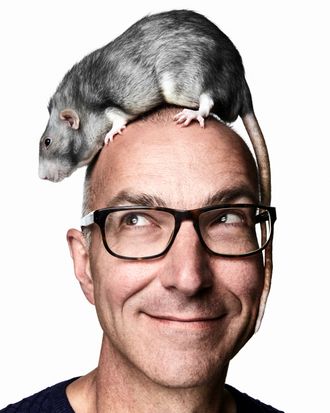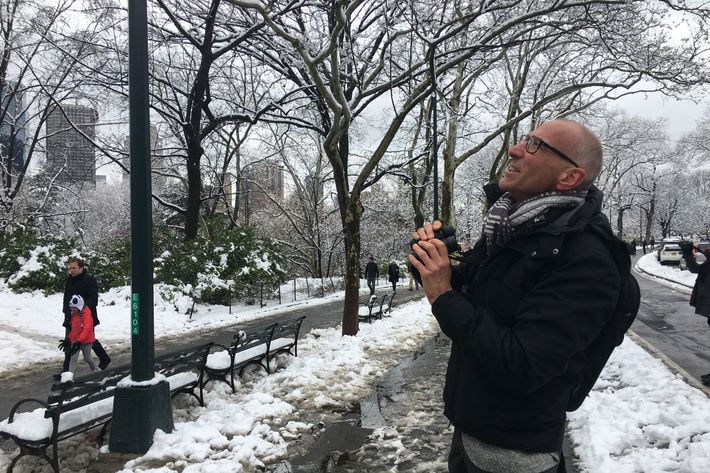
You know how it goes when you put down roots in Brooklyn for good. The visits from your Manhattan friends get less frequent, and eventually taper off. You mix with them less and less, and then when you do get together, your life just seems a little different. You’ve just, I don’t know, evolved.
It goes double if you’re a mouse.
That, at least, is what Menno Schilthuizen is explaining to me. He’s an evolutionary biologist, visiting from the Netherlands, and he’s agreed to walk me through his new book Darwin Comes to Town, out this week from Picador. It is a tour of city life through (among other creatures) what he cheerily calls “urban creepy-crawlies,” and its central point is that evolution is not always the grindingly slow, nearly invisible process we usually think it is. Although it takes millions of years for new species to appear, little adaptations appear constantly, in just a few generations, sometimes in a park near you.
White-footed mice aren’t the rodents you find in your building’s basement but instead are a species that lived on this group of rocks we call home even before it came to be known as New Amsterdam. Significant populations linger in Central Park, Prospect Park, and various other green patches around town. Except that, since the asphalt came in, those groups no longer intermingle — and a study, cited in Schilthuizen’s book, has found that the DNA of the Manhattan mice no longer matches that of their Brooklyn counterparts. “Central Park,” he explains, “is much more heavily visited than the other parks in New York, and there’s much more discarded food.” So the local mice have evolved to favor genes that help them handle higher-fat diets, like the bits of pizza and nachos and cheese fries that we leave for them. They’ve also picked up some unique disease and fungal resistances — probably, he says, “because they suffered some epidemic that didn’t spread to the other parks.” Nor are they the only species that have undergone such evolution: A Rockefeller University study found that East Side and West Side roaches can be distinguished by their DNA — they came from different populations, and even after centuries, they haven’t mixed much — and both of those are different from Brooklyn roaches. In Los Angeles, mini-populations of bobcats, cut off from each other by uncrossable freeways, have also evolved apart.
“A red-tailed hawk!” Schilthuizen says as his eyes zip skyward. “We have peregrine falcons in Europe, but not these.” We’re stepping through the Children’s Gate into into Central Park, and we’d figured on looking at some city wildlife, but a wet, sloppy snowfall has buried those plans. “I was hoping to see some snails on the trees,” Schilthuizen says, peering into the slush, “but not today.” There are (at least on sunnier days) indeed snails to be found in big cities, including New York, and they too have changed within our lifetimes. “Their shell colors are becoming lighter all over Europe — it protects them, because the dark ones get overheated more easily and more frequently.” It is a quick-time response to climate change.
To be clear, we’re not about to see a bunch of new mutant creatures sprouting legs and crawling out of Bethesda Fountain. The white-footed mice look about the same from borough to borough, with the slightest variation in ear shape. The genes being selected, on this very short scale of time, give them characteristics that were already inherent but provide some particular protection or advantage. “There are a few things,” Schilthuizen explains, “that make a species pre-adapted, as I call it, for being an urban animal, like for example living in rocky habitats in the wild, so then they can also live among buildings.” And, more generally, we coexist well with species that can handle fast change. “Cities are unstable habitats — that’s what makes them biologically interesting!” And things do change fast here: Animals that had barely adjusted to incandescent lights at night are now getting socked with LED lighting, which is far brighter and broader-spectrum than the old sodium street lamps and neon tubes of the past. Moths, in particular, have had a hard time coping with artificial light at night, colloquially known as ALAN. Many winged insects end up “sitting mesmerized by the light or twirling around when they should be looking for food.”

Speaking of adaptation, he and I give up on the park, because there was not much to be seen beyond that hawk and a few chilly sparrows. At a café nearby, I ask him about animals we live with but don’t like. “There are shared characteristics, but it’s very hard to see whether something will be a pest. Like cockroaches — they came on ships, but maybe even before that, they lived in caves. I do a lot of research in caves in the tropics, and you have quite a number of those big cockroaches that are very much like the ones we live with.” And caves, like cliffs, are in some ways where we still live: “We all have basements, it can be a bit humid, a bit dark. A lot of species that live in our houses are basically and recently cave species, including bedbugs and fleas and parasites that mostly used to live on bats. They hopped to people, and they followed us to our houses and apartment buildings.” I have a brief flashback to a brownstone apartment that was extremely well equipped with recent cave species, and nod.
You may think that only a few sturdy species would adapt to city life and the rest would go extinct, and that’s somewhat true. A bird that can nest only in one fragile coastal zone is never going to make it on Third Avenue. But urban areas, weirdly, have begun to serve nature better in some ways than rural ones do. One study Schilthuizen mentions took place in Sheffield, England, and it found that there were more insect and plant species in the city’s gardens than there were anywhere else in Britain. “Cities can actually have a higher diversity than the surrounding countryside,” he says. “Every person likes to create their own garden, with its own habitat, and insects can survive in a single garden.” And then, he adds, the giant monocultures of modern agribusiness are anything but hospitable. “There are lots of little tiny bits of habitat in the city — drains, gutters, old walls — that particular plants or insects or other organisms like. It used to be that there were lots of little corners like that in the countryside. But it’s been optimized for the highest possible agricultural output.” The result? All the “small-scale, cute stuff” that favors biodiversity has disappeared.
But what about our toxins, especially in cities with industrial pasts? Pigeons in some cities have evolved to move lead through their systems more efficiently, dumping it into their darker feathers. Their wing shapes have also changed to facilitate short, sharp turns, the better to get away from cats and cars. Starlings, too, show some of the same adaptations.
Of course, the inevitable question that comes up is about people. Are we gradually breeding New Yorkier New Yorkers, individuals who are singularly suited to this island city? Might we evolve to talk faster, to spot an unoccupied taxi’s roof light through traffic at an even greater distance, to detect the best Chinese takeout in a six-block radius by pure instinct? Sadly, it won’t happen: Any fine-grained evolution is undetectable amid the much larger mixing wrought by immigration and mobility. Such adaptation was once a possibility — “there is some evidence from the first cities, from DNA of people in graveyards in the Middle East, that early urbanites had genes protecting them from tuberculosis, which you don’t find in rural skeletons” — but those processes no longer really apply. Most people live relatively long lives, and for quick evolutionary adaptations, you need “differential survival,” Schilthuizen explains. Humans produce only three or four generations per century, and so instead we rebuild the landscape to suit (some of) our abilities and preferences, instead of seeing our DNA change to suit.
By contrast, mosquitoes have an extremely fast life cycle, and theirs is a story, then, of extremely swift urban evolution, especially in one city environment. In London, they live and breed in dark damp corners of train tunnels (it being England, there are plenty of puddles), and have, over the years, become a distinct species, Culex molestus, the London Underground mosquito. And a study Schilthuizen discusses in Darwin Comes to Town, conducted by the geneticist Katharine Byrne, has established that not only is that mosquito a distinct species; each subway line now has its own distinct variant. They never cross paths; it’s just too far to fly from puddle to puddle. As she told Schilthuizen, the only way they could exchange DNA would be “for all of them to change trains at Oxford Circus station.”






























